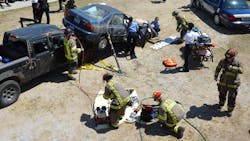The Foundation of Community Risk Reduction
In this day and age, the U.S. fire service is seeing the growth and spread of community risk reduction (CRR). The adoption of the CRR practice goes along with the “all hazards response” mindset that our profession adopted nearly a generation of firefighters ago.
Anyone who spent more than a shift on a front-line company in the past decade can see that we devote far more time, effort and resources responding to non-fire calls than ever before, but what are we responding to? Can you name the top five things that are hurting or killing those who are in your response district?
Well, if your agency were to work through a CRR program and conduct a community-risk assessment, you could figure out almost exactly what’s hurting your community every day.
The foundation is data
CRR is an amazingly beneficial program for any emergency response agency. The information that’s gathered can help to justify budgets and to improve service levels and can save lives and property. So valuable is this process that a group called Vision 20/20 created a free step-by-step guide that you can use in your community (www.strategicfire.org).
Now, like a great fire station, all things that are built must have a solid foundation. The first step in your CRR program should be a community-risk assessment, or, in short, an up-close-and-personal look at your data. I know, I know, “data” is a four-letter word, but CRR is, very simply, a data-driven program that’s intended to minimize the specific things that hurt and kill people who are in your community. Consider data as a crystal ball. Based on what happened, you can estimate with a good amount of certainty what will happen.
So, it stands to reason that collecting and analyzing data are critically important to saving the lives of those who you swore to protect. Armed with the data, you can take steps to reduce the frequency of it happening and minimize the damage when it happens. If you are lucky, you can prevent it from happening all together.
The entire CRR process hinges on data, and it must be good data, so you must know where to get it. Every U.S. emergency response agency creates reports that are based on what it does: run reports, patient care reports, inspection reports, etc. Those reports are the start of your data collection and will paint the picture of what’s happening in your response district. In most cases, those reports are filed with a state or federal agency (think National Fire Incident Reporting System, or NFIRS), and a collective data report often can be generated simply by asking those collection agencies or even printing from their website at little or no cost.
Now, before you raise a red flag about patient care information and HIPAA laws, a report on how many heart attacks occurred in your community doesn’t violate HIPAA as long as names, addresses and personal information aren’t included. Most state health agencies and some hospitals are happy to share their data on the top illnesses/injuries and likely can tell you what the leading illnesses/injuries are in your community, all without violating HIPAA—just be sure to ask for a discharge/diagnosis report, because people often go to the hospital for one thing (arm pain) and end up diagnosed with something different (cardiac deficiency).
Tapping into others
To ensure as complete a picture as possible, you should reach out to anyone who tracks community safety. Consider talking to other emergency response agencies, insurance companies, social service offices and state/federal agencies, such as the Department of Motor Vehicles, social agencies (think Red Cross, Salvation Army, etc.), the U.S. Fire Administration, FEMA, the Centers for Disease Control and Prevention and Department of Homeland Security.
When you request the data, understand that you must look at a minimum of three years of data. If you can get 5 or even 10 years of data, all the better, because trending or recognizing patterns is what this is all about. If this year you only ran a handful of automobile accidents and that’s the only data that you consider, you would conclude that automobile accidents aren’t a priority.
However, if in the past 3–5 years you responded to more automobile accidents than anything else, you surely would want to place a priority on preventing automobile accidents. The more that you understand, the better prepared that you can be to respond and prevent. Ultimately, the more sources of good information, the better your data, the more focused your community-risk assessment and, thus, the greater the positive effect on your community.
Now that you have all of this information, you must figure out what it all means. You must analyze what it tells you about your community. It might seem like a monumental task to look through so many reports and details about your response district, but don’t allow yourself to get overwhelmed. It really is just a matter of comparison and prioritization.
Furthermore, don’t feel as though you must do this alone. Consider that we don’t do anything alone in the fire service, and the CRR process should be no different. CRR is a communitywide process and should include partners that have a vested interest in the safety of the community. When it comes to analyzing your data, consider reaching out to a local college statistics professor, a high school math teacher, a state data specialist or anyone who can help you to understand all that you collected.
Your analysis is a matter of identifying what events most commonly hurt and kill your neighbors. To what type of call did you respond most? To what type of call did you respond second most? Third? Fourth? You get the point. You can create a list of your most frequent types of calls for each year of data that you collect. Do you see a common call type from year to year? Are you running more lift-and-assists than you are fires? I bet you are. Now, you can prove it.
Beyond your data
Look at annual state response data. To what are departments across your state responding? Are most of the departments across your state responding to the same type of calls as often as you are? What if they are? What if they aren’t? What does it all mean?
Your analysis should include a comparison of your data with data that are from state and even federal levels for a couple of important reasons. First, if your state or the nation shares in your frequent call type, perhaps it has resources (pre-established programs, personnel, funding) that can help you to address the issue in your front yard. On the other hand, if there’s a cause of injury/death that seems to happen often across your state or the nation but isn’t something that happens often or at all in your jurisdiction, wouldn’t you like to know why, so you can continue to keep it out of your community?
This is the core of analyzing your data: How can knowing what is hurting/killing the people who are in your community help you to respond, reduce and prevent such tragedy?
Fire somewhere in the top five
You now should have a rather good idea of how you want to prioritize the risks that you have. Having said that, this is where I say that the prioritizing process of CRR is worthy of its own lengthy article, so, in short, let me share that it isn’t as easy as it might first appear. Consider that most U.S. fire departments respond to actual fires fewer than four out of 100 times that they run down the road with lights and sirens on.
That means that your analysis will show that fire is a rare occurrence and, therefore, should be prioritized low on your list of CRR goals and objectives. I would caution you about believing that, if only because there’s no one else in the firefighting business. Because we are firefighters, I might suggest that you keep fire reduction/prevention in your top-five list if only because that’s who we are and that’s what’s expected of us.

Lee Levesque
Lee Levesque is a 30-plus-year veteran of the fire service and veteran of the U.S. Army who currently serves with the Burton, SC, Fire District as a member of the Beaufort County, SC, First Responders Project, which is a community health program that targets opioid overdoses. He holds a bachelor’s degree in fire science and emergency administration and graduated from the South Carolina State Firefighters Association’s (SCSFA) Leadership Institute. Levesque is a past president of the SCSFA’s Life Safety Section. He also served on a number of International Fire Service Training Association validation committees to establish the baseline for emergency response worldwide.






